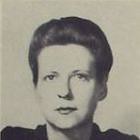 |
| Dell Mapback #209 (1948) Cover art by Gerald Gregg |
Although Lucille is happy with her marriage, it quickly becomes obvious that her step-children Polly and Martin are hostile toward her, and Polly hates her father for having married again after her mother’s death. Mildred was murdered one night in the snowbound park, and although there are stories of a figure with an axe seen in the neighbourhood at that time, her killer has never been caught. Although the children have never accepted her, Lucille is a calm and organised person, and is valued as such by Andrew and his unmarried sister Edith.
 |
| Margaret Millar (1915 - 1994) |
The next day a shabby-looking stranger visits the house to deliver a box to Lucille. A housemaid hears a scream from her room, and later that day the family discover that she’s disappeared. Lucille is eventually found in a hotel room, but she is now in an unresponsive state, and is placed in the Pentree nursing home under the care of Dr Goodrich. The mysterious box remains undiscovered.
The case is taken up by Inspector Sands, who soon connects Lucille with another murder and reopens the investigation into Mildred’s murder; an investigation he believes was badly mishandled by another member of the force, years before.
 Margaret Millar’s story explores the motivations of complex characters in intensely structured environments; the iron gates of the title refer to the gates of the Pentree asylum, which isn’t far removed either geographically or in nature to the Morrow family’s house at the edge of the park. The first acts of violence strike outside of these environments, the strangely tranquil snowbound park or the squalid city backstreets. The dream with which the novel opens sets the mood for the rest of the book, this at its most intense in the chapters dealing with Lucille’s residence in the asylum, when her deranged state is conveyed through disturbing stream-of-conscious passages (and James Joyce is name-checked here). Millar’s husband John Ross Macdonald sometimes introduced gothic motifs in his novels, and here there’s a similar suggestion of something fossilised or corrupt at the heart of a romanticised setting, the house in the frozen waste of the park.
Margaret Millar’s story explores the motivations of complex characters in intensely structured environments; the iron gates of the title refer to the gates of the Pentree asylum, which isn’t far removed either geographically or in nature to the Morrow family’s house at the edge of the park. The first acts of violence strike outside of these environments, the strangely tranquil snowbound park or the squalid city backstreets. The dream with which the novel opens sets the mood for the rest of the book, this at its most intense in the chapters dealing with Lucille’s residence in the asylum, when her deranged state is conveyed through disturbing stream-of-conscious passages (and James Joyce is name-checked here). Millar’s husband John Ross Macdonald sometimes introduced gothic motifs in his novels, and here there’s a similar suggestion of something fossilised or corrupt at the heart of a romanticised setting, the house in the frozen waste of the park.My copy of The Iron Gates (UK title Taste of Fears) was included in a paperback volume, Alfred Hitchcock presents Stories for Late at Night part 2 (this volume actually edited by Robert Arthur), published by Pan 1965. Millar wrote one other Inspector Sands novel, Wall of Eyes (1943).
View all my reviews
No comments:
Post a Comment